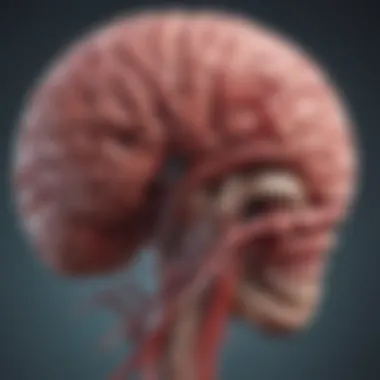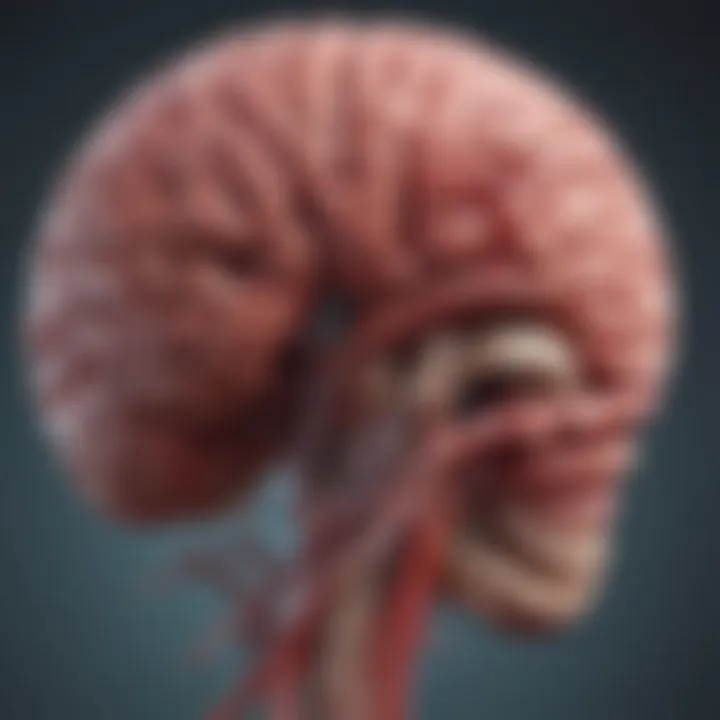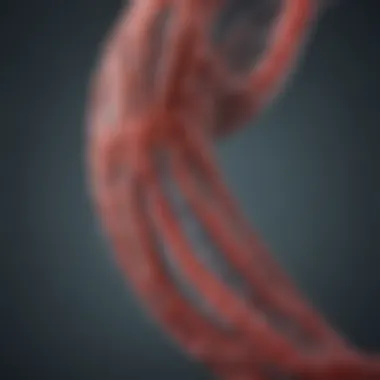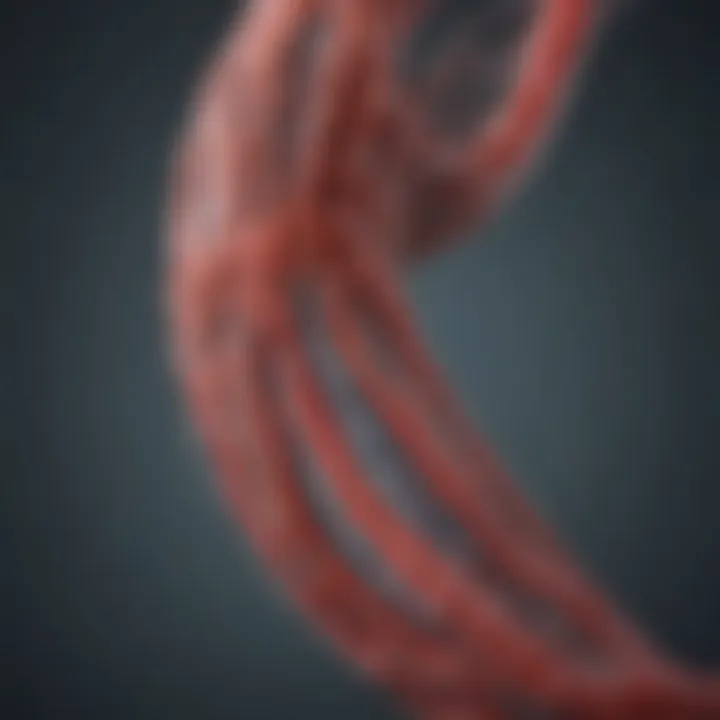Comprehensive Overview of Brain Aneurysms and Coiling


Intro
Brain aneurysms represent a crucial threat to neurological health, with potential for severe consequences. They are abnormal bulges in the walls of blood vessels in the brain. Understanding the implications of these aneurysms is essential for medical professionals and patients alike. This piece serves to dissect the topic, covering the types, causes, symptoms, and treatment options, specifically focusing on endovascular coiling. A coherent understanding of such conditions nurtures better patient care and informed decision-making.
Research Overview
Key Findings
Research into brain aneurysms reveals significant data about their prevalence and management. Studies indicate that:
- Approximately 1 in 50 individuals have a brain aneurysm.
- They are more prevalent in women than men.
- Risk factors include hypertension, smoking, and family history.
Understanding these statistics helps in assessing patient risk and the necessity for monitoring.
Study Methodology
To compile relevant information for this comprehensive overview, a variety of medical journals, clinical studies, and expert opinions were examined. The methodology involved:
- Reviewing peer-reviewed articles from established journals.
- Analyzing case studies that discuss patient outcomes.
- Synthesizing findings from reliable health organizations.
This approach ensured that the conclusions drawn are grounded in solid medical evidence and reflect current practices in the field.
Background and Context
Historical Background
Brain aneurysms have been recognized since ancient times, but significant advancements in their understanding have occurred over the past few decades. The introduction of imaging technologies, like MRI and CT scans, enabled clinicians to identify these aneurysms more accurately.
Current Trends in the Field
Currently, patient management for brain aneurysms has evolved, with an emphasis on minimally invasive procedures. Endovascular coiling is increasingly preferred over traditional surgical approaches due to its reduced recovery times and lower complication rates. As medical technology progresses, ongoing studies and trials inform best practices and therapeutic innovations.
"With each study, we uncover more about the complexities of how brain aneurysms develop and can be treated, influencing patient outcomes positively."
This article aims to illuminate such complexities, fostering a better understanding among healthcare providers and patients. The focus now shifts to elucidating the clinical aspects, treatment options, and implications for patient care.
Intro to Brain Aneurysms
Understanding brain aneurysms is crucial for both healthcare professionals and patients. The topic highlights the complexities surrounding a medical condition that can lead to severe health issues or even be life-threatening. Knowledge of this subject empowers people to recognize symptoms, understand treatment options, and appreciate the importance of regular medical check-ups.
Brain aneurysms occur when there is a weak spot in a blood vessel wall in the brain. This weak area bulges or balloons out, which can potentially rupture. In fact, aneurysms are often asymptomatic until they become critical, making education and awareness key components in prevention and early intervention. Moreover, studying brain aneurysms can lead to better understanding and innovations in treatment methods.
Patients diagnosed with brain aneurysms often experience anxiety and confusion. Consequently, education becomes pivotal not only for their knowledge but also for their mental well-being. By providing clear, reliable information, this article aims to serve as a resource that elucidates the nuances of brain aneurysms, thereby fostering informed discussions between patients and healthcare providers.
Definition of Brain Aneurysm
A brain aneurysm, often called a cerebral aneurysm, is a localized swelling or ballooning in the wall of a blood vessel in the brain. This condition is the result of a weakness in the vessel wall. These aneurysms can vary significantly in size and shape, and they can be classified into different types based on their morphology. Although many aneurysms remain dormant, the risk of rupture can lead to severe complications, including brain hemorrhages.
Prevalence and Demographics
Brain aneurysms are relatively common. It is estimated that about 1 in 50 people in the United States has one. The prevalence increases with age and is more common in women than in men. According to various studies, approximately 60% of aneurysm patients are female.
Understanding the demographics surrounding brain aneurysms is essential. Certain factors such as family history, high blood pressure, and smoking can intensify the risk of developing aneurysms. This knowledge serves a dual purpose: it can help identify high-risk individuals and promote preventive healthcare measures.
The key to effective management lies in recognizing potential symptoms and understanding risk factors.
Types of Brain Aneurysms
Understanding the various types of brain aneurysms is crucial for both medical professionals and patients. Each type carries unique characteristics, implications, and treatment challenges. Identifying the correct type enhances diagnosis accuracy and informs treatment selection, ultimately influencing patient outcomes. Here, we discuss the three primary types of brain aneurysms: saccular, fusiform, and other variants.
Saccular Aneurysms
Saccular aneurysms, often referred to as "berry" aneurysms, are the most common type. They form as a small outpouching on one side of the blood vessel wall and are typically spherical in shape. These aneurysms are generally found at the junction of arteries in the brain and can vary in size.
Key points about saccular aneurysms include:
- Prevalence: They account for about 85% of all brain aneurysms.
- Rupture risk: Saccular types are known for a higher risk of rupture, leading to subarachnoid hemorrhages.
- Symptoms: Often asymptomatic, but larger saccular aneurysms may cause headaches, vision impairment, or neurological deficits.
Understanding the nature of saccular aneurysms is important, especially regarding preventive strategies and timely treatment.
Fusiform Aneurysms
Fusiform aneurysms are less common and differ from saccular types in shape and formation. They present as a spindle-shaped enlargement of a blood vessel rather than a localized bulge. These aneurysms affect the entire circumference of the artery.
Features of fusiform aneurysms include:
- Location: Often seen in the basilar artery and vertebral arteries.
- Rupture potential: Generally, they are less likely to rupture than saccular aneurysms but can still cause significant complications.
- Symptoms: Symptoms may vary; many patients remain asymptomatic until complications arise.
Awareness of fusiform aneurysms influences clinical assessment and treatment options.
Other Variants


In addition to saccular and fusiform aneurysms, other variants exist, though they are less frequently encountered. These include:
- Dissecting aneurysms: Results from a tear in the artery wall, leading to blood flow between layers of the vessel.
- Mycotic aneurysms: Formed in response to an infection, these can develop rapidly and present unique challenges for treatment.
- Traumatic aneurysms: Resulting from a head injury, these require a specialized approach.
Each type requires tailored treatment and management strategies based on its specific characteristics and potential risks.
Understanding the different types of brain aneurysms is essential for effective diagnosis and treatment, contributing thus to improved outcomes for patients.
In summary, distinguishing these aneurysms helps better understand their implications, risks, and management options. The next sections will delve deeper into the causes and risk factors related to these medical conditions.
Causes and Risk Factors
Understanding the causes and risk factors associated with brain aneurysms is crucial. Aneurysms develop when the blood vessel wall weakens, leading to bulging. Knowing the origins of this condition can aid in prevention, early detection, and informed treatment options. This section will dissect various aspects including genetic predispositions, environmental influences, and lifestyle choices.
Genetic Predispositions
Genetic factors play a significant role in the development of brain aneurysms. Various studies indicate that having a family history of aneurysms may increase an individual's risk. Specific genetic mutations can contribute to structural weaknesses in blood vessel walls. Researchers have identified several genes that may be implicated in this process, including those associated with connective tissue disorders.
It is important for individuals with a family history of aneurysms to engage with healthcare providers. Genetic counseling can help determine risk and guide monitoring strategies. Screening may be recommended for at-risk family members to catch potential aneurysms early.
Environmental Influences
Environmental factors are dynamic and can significantly impact the development of aneurysms. High blood pressure, or hypertension, is a prime contributor. Chronic stress has also been shown to affect vascular health adversely. Additionally, exposure to toxins or certain infections may play a role, although these links require further research.
Understanding these environmental influences is beneficial for prevention. For instance, monitoring blood pressure can mitigate risks. Seeking interventions for chronic stress, such as counseling and mindfulness practices, may also reduce overall risk.
Lifestyle Choices
Lifestyle choices encompass several habits that can influence health and by extension the risk of developing brain aneurysms. Smoking is a known risk factor, leading to endothelial damage and increased blood pressure. Similarly, a diet low in essential nutrients can contribute to vascular health decline.
Physical activity is vital in promoting cardiovascular health. Regular exercise helps maintain healthy blood pressure levels and supports overall well-being. Reducing alcohol intake is also advisable, as excessive consumption can have detrimental effects on vascular integrity.
In summary, the interplay between genetics, environmental factors, and lifestyle choices is critical in understanding brain aneurysms. Awareness of these causes and risk factors enables individuals to take proactive measures to reduce their risk.
Clinical Implications of Brain Aneurysms
Understanding the clinical implications of brain aneurysms is crucial for both healthcare professionals and patients. This topic encompasses the symptoms that may arise from the presence of an aneurysm, as well as the diagnostic techniques utilized to confirm the condition. Recognizing the signs and understanding how to detect aneurysms can greatly influence patient outcomes and guide treatment decisions.
The clinical implications extend beyond just diagnosing aneurysms; they involve assessing how these anomalies can affect an individual’s overall cognitive and physical health. The potential for serious complications necessitates proactive management and ongoing observation. Thus, a comprehensive understanding of symptoms and diagnostic options is essential for effective treatment and patient care.
Symptoms
Symptoms of a brain aneurysm can vary widely, often depending on the size and location of the aneurysm. Many individuals may not experience noticeable symptoms until the aneurysm ruptures, leading to a subarachnoid hemorrhage, which is a critical condition. Symptoms that may indicate the presence of an aneurysm include:
- Severe headache: Often described as the "worst headache of one's life."
- Nausea and vomiting: This may occur along with increased intracranial pressure.
- Vision changes: Blurred or double vision can occur, indicating pressure on nearby structures.
- Neurological deficits: Weakness in limbs, difficulty speaking, or even loss of consciousness.
Understanding these symptoms can lead to early diagnosis and treatment, potentially preventing complications.
Diagnosis
Prompt and accurate diagnosis of brain aneurysms is critical for effective management. Various methods are employed to visualize the aneurysm and assess its characteristics. Each technique offers distinct advantages and may be selected based on the individual patient's medical history and circumstances.
Imaging Techniques
Imaging techniques are pivotal in diagnosing brain aneurysms. Magnetic resonance imaging (MRI) and computed tomography (CT) scans are commonly used. These methods allow for detailed visualization of brain structures, facilitating the identification of anomalies.
The key characteristic of imaging techniques is their non-invasive nature, which provides detailed images without requiring any surgical intervention. This approach is advantageous as it reduces patient discomfort and risk. However, the quality of images may not always be sufficient to reveal small or complex aneurysms.
Cerebral Angiography
Cerebral angiography is considered one of the gold standard methods for diagnosing brain aneurysms. This minimally invasive procedure involves introducing a catheter into the blood vessels and injecting a contrast dye to visualize the blood flow in the brain.
A key characteristic of cerebral angiography is its ability to provide detailed images of the blood vessels, helping to identify the size and shape of the aneurysm. It is a beneficial tool because it can not only diagnose but also assist in procedural planning for treatments such as endovascular coiling. However, it carries risks such as bleeding or infection at the catheter site, which need consideration before proceeding.
Non-Invasive Methods
Non-invasive methods such as CT angiography (CTA) and MR angiography (MRA) also play a critical role in the diagnosis of brain aneurysms. These techniques provide imaging without the need for invasive procedures.
The key characteristic of non-invasive methods is their safety and convenience for the patient. They are beneficial as they streamline the diagnostic process and reduce risks associated with invasive techniques. Despite these advantages, the downside could be a lack of detail compared to traditional angiography.
Effective diagnosis of brain aneurysms hinges on the appropriate use of imaging techniques. Each method has its unique strengths and weaknesses, which must be considered to achieve the best patient outcomes.
The combination of understanding symptoms and utilizing effective diagnostic methods underscores the importance of recognizing brain aneurysms early, ultimately contributing to improved treatment strategies and patient care.
Treatment Options for Brain Aneurysms
The treatment options for brain aneurysms are essential in managing this complex medical condition. Each treatment method has its own set of indications, benefits, and risks. Understanding these options is critical for healthcare professionals and patients to make informed decisions about managing a brain aneurysm.
Surgical Clipping
Surgical clipping is a well-established technique used to treat brain aneurysms. In this procedure, a neurosurgeon places a clip across the neck of the aneurysm. This stops blood flow into the aneurysm, reducing the risk of rupture. The process requires opening the skull, which is invasive but can be effective for certain types of aneurysms.


The effectiveness of surgical clipping often depends on the aneurysm's location and size. While this method can be very effective, it carries risks such as infection, bleeding, and neurological complications.
Endovascular Coiling
Overview of the Procedure
Endovascular coiling is a minimally invasive procedure that involves inserting a catheter through an artery, generally in the groin. The catheter is then navigated to the site of the aneurysm in the brain. Once there, tiny coils are deployed into the aneurysm. These coils promote clotting and reduce blood flow, thus preventing rupture. This method is often chosen for its less invasive nature compared to surgical clipping.
The significance of endovascular coiling lies in its ability to allow faster recovery for patients. Its popularity stems from the minimal incision, which reduces the likelihood of complications associated with traditional surgery. However, the success of this approach depends on the aneurysm's characteristics.
"Endovascular coiling offers a less invasive alternative to traditional surgical methods, making it suitable for many patients who might be at a higher risk for surgery."
Indications for Use
Endovascular coiling is indicated for patients with specific types of brain aneurysms, particularly those that are located in areas difficult to access surgically. This treatment is often considered for small to medium-sized saccular aneurysms.
The primary characteristic of this method is its ability to treat patients who may not tolerate extensive surgery effectively. Additionally, it is beneficial for those who experience recurrent aneurysms post-clipping. The unique aspect of endovascular coiling is its capability to adapt to various aneurysm shapes and sizes. Despite its advantages, it is essential to note that not all aneurysms are suitable for coiling, and some may still require surgical clipping.
By understanding these treatment options, patients and healthcare providers can better navigate the complexities of managing brain aneurysms. It is crucial to evaluate individual situations to determine the most appropriate approach.
Endovascular Coiling Technique
Endovascular coiling represents a critical advancement in the treatment of brain aneurysms. This minimally invasive option provides an effective means to manage aneurysms, reducing risks associated with more invasive surgical methods. Understanding this technique is essential as it allows for a targeted intervention that can lead to better patient outcomes.
The primary goal of endovascular coiling is to occlude the aneurysm. By doing this, it prevents the aneurysm from expanding further or rupturing, which can lead to hemorrhagic stroke. The coiling process is less traumatic to the patient, often resulting in shorter recovery times and fewer complications compared to traditional surgical clipping.
Additionally, the endovascular approach is typically done under sedation and requires only a small incision. This provides an attractive option for both patients and healthcare professionals looking for efficient yet safe treatment pathways.
Procedure Description
The procedure of endovascular coiling begins with the patient being prepared in a sterile environment. The interventional radiologist inserts a catheter into a blood vessel, generally located in the groin. The catheter is then carefully navigated through the vascular system to reach the site of the aneurysm in the brain.
Once in position, a series of small, soft coils made of platinum are delivered through the catheter and placed into the aneurysm sac. These coils work by promoting thrombosis, leading to the eventual occlusion of the aneurysm. As blood flow is obstructed, the aneurysm is effectively sealed off from the bloodstream, mitigating the risk of rupture.
The entire procedure lasts approximately one to two hours, and patients are typically monitored closely following the intervention.
Equipment Used
The effectiveness of endovascular coiling largely depends on the specialized equipment utilized throughout the procedure. Key components include:
- Microcatheter: A thin tube essential for delivering coils into the aneurysm.
- Guidewire: A wire that assists with the navigation of the microcatheter through complex vascular architecture.
- Platinum Coils: Small coils designed to fill the aneurysm.
- Fluoroscopy: Imaging technology that provides real-time x-ray visuals, guiding the physician during the procedure.
All these instruments work together to ensure precision and safety during the coiling procedure.
Role of Interventional Radiologists
Interventional radiologists play a pivotal role in executing the endovascular coiling technique. Their expertise in minimally invasive procedures allows them to accurately navigate intracranial vessels and manage the complexities of each case.
These specialists are trained to assess the aneurysm’s morphology, which helps determine the most effective approach for coil placement. In addition to technical skills, the ability to make quick decisions during the procedure is crucial.
Moreover, interventional radiologists also provide valuable post-procedure care and can promptly identify any complications that may arise. Their continuous presence ensures a thorough follow-up process, which is vital for patient recovery.
"Endovascular coiling has revolutionized the management of brain aneurysms, offering an effective and less invasive option to patients."
Understanding the intricacies of the endovascular coiling technique equips both patients and healthcare professionals with knowledge crucial for informed decision-making.
Benefits of Endovascular Coiling
The use of endovascular coiling as a treatment for brain aneurysms has gained significant attention in contemporary medical practice. This method offers various advantages, making it an appealing choice for both patients and clinicians. Its effectiveness and safety have led to a greater acceptance in treating complex cases that may have had limited options previously.
Minimally Invasive Nature
One of the primary benefits of endovascular coiling is its minimally invasive nature. Unlike traditional surgical clipping, which requires a craniotomy, endovascular coiling can be performed through a small incision, often in the groin area. This approach significantly reduces the trauma to the surrounding tissues. The catheter is guided through the blood vessels to the site of the aneurysm, allowing for a precise delivery of coils without the need for extensive surgery.
This minimally invasive method leads to a typically shorter hospital stay. Most patients are often discharged within a couple of days post-procedure, which is a stark contrast to longer recovery times associated with more invasive surgical techniques. The procedures also tend to have a lower risk of infection and less postoperative pain.
Reduced Recovery Time
Recovery time is another critical element that highlights the advantages of endovascular coiling. Patients generally experience a faster recovery period. Because the technique limits the disruption to the skull and brain, most individuals can resume normal activities sooner.
Patients may experience mild discomfort but can often return home within 24 to 48 hours. Moreover, follow-up appointments can be scheduled at regular intervals without the need for prolonged stay in rehabilitation. This efficiency in recovery can prove vital for patients looking to restore their routine and avoid lengthy absences from work or other responsibilities.
Patient Outcomes
Evaluating the patient outcomes associated with endovascular coiling showcases its effectiveness. Studies suggest a favorable outcome for many individuals after undergoing this procedure. The long-term success rate of coiling treatment has been encouraging, with many patients maintaining a good quality of life post-treatment.
A notable outcome is the lower recurrence rate of aneurysms. Patients treated with endovascular coiling often have a reduced chance of having their aneurysm return compared to other surgical options. Regular follow-ups and imaging studies help in early detection and management of any complications, contributing to better overall patient prognosis.
In summary, the benefits of endovascular coiling, such as its minimally invasive approach, reduced recovery time, and promising patient outcomes, position it as a crucial method in managing brain aneurysms. The informative advantages serve both patients and healthcare providers in making the best treatment decisions.
Potential Complications of Coiling


The discussion surrounding the treatment of brain aneurysms via endovascular coiling must include the potential complications that can arise during and after the procedure. While endovascular coiling is often favored for its minimally invasive nature, it is essential for both healthcare providers and patients to understand the various risks involved. Being aware of these complications can help patients make informed decisions about their treatment options.
Immediate Risks
Endovascular coiling, although safer than traditional surgical methods, carries immediate risks that should not be overlooked. Among the immediate complications, the following are notable:
- Hemorrhage: There is a risk of bleeding during the procedure, which could result in significant neurological complications.
- Vascular damage: The catheter used for coiling can potentially damage blood vessels, leading to clot formation or disruption of blood flow.
- Infarction: There is a possibility of blood supply being compromised to surrounding brain tissue, resulting in ischemic strokes.
Doctors typically monitor patients closely during and immediately after the procedure to identify and address any complications quickly. Proper technique and experience in interventional radiology are crucial in minimizing these immediate risks.
Long-Term Effects
Beyond immediate risks, long-term effects of endovascular coiling are also a significant concern. These effects can impact the patient's quality of life and medical outcomes. Key long-term effects include:
- Recurrence of the Aneurysm: One notable concern is the potential for the aneurysm to recur after treatment. Follow-up imaging is important to assess the stability of the coil and to check for any changes in the aneurysm's shape or size.
- Cognitive Changes: Some patients report cognitive changes or difficulties, which may arise from the procedure or from the original aneurysm. This can include challenges in memory, concentration, and overall brain function.
- Possible Need for Additional Procedures: Sometimes, the need for further interventions arises if the coiling is not fully effective, leading to additional healthcare visits.
"Awareness of complications empowers patients and enhances their ability to engage in informed discussions with healthcare providers."
Ensuring follow-up care, such as regular imaging and consultations, is vital for monitoring any long-term effects. This comprehensive approach can lead to improved patient outcomes and a better understanding of their condition.
Post-Operative Care and Monitoring
Post-operative care and monitoring are critical components following the endovascular coiling procedure for brain aneurysms. This stage of care directly influences patient recovery and overall outcomes. Ensuring proper follow-up is essential for detecting complications early, managing symptoms, and facilitating effective rehabilitation. Patients can gain a better quality of life when these aspects are efficiently handled.
Post-operative care involves not just observing for immediate complications but also addressing patient comfort and recovery. This includes pharmacological management of pain, possible side effects from anesthesia, and emotional support. A multidisciplinary approach often yields the best results, ensuring that all aspects of the patient’s health are considered.
Short-Term Follow-Up
Short-term follow-up is a vital aspect of post-operative care. This phase usually spans the first few weeks after the procedure. Key considerations during this period include:
- Neurological Assessment: Regular evaluation of neurological status helps identify any immediate post-procedural complications, such as bleeding or ischemia.
- Imaging: Initial imaging, often through CT scans or MRIs, is performed to assess the placement of the coil and the condition of the aneurysm.
- Symptom Monitoring: Patients need to report symptoms like severe headaches, vision changes, or neurological deficits. Prompt communication can catch potential issues early.
The first visit typically occurs within one to two weeks post-surgery. This appointment allows the healthcare provider to address any immediate concerns, tweak medications, and provide instructions for daily activities.
Long-Term Monitoring
Long-term monitoring extends beyond the initial recovery phase. It is crucial for predicting late complications and ensuring the continued health of the patient. This process can involve a variety of elements:
- Regular Imaging: Follow-up imaging is often performed every six months to a year to monitor the stability of the treated aneurysm and to look for any signs of regrowth.
- Routine Check-Ups: Scheduled visits help maintain an open line of communication with healthcare providers concerning any new or ongoing symptoms.
- Patient Education: Educating patients about the warning signs of potential complications enhances proactive health management. Patients should understand what symptoms necessitate immediate medical attention.
Long-term monitoring not only helps manage potential risks but also provides reassurance to patients. Continual support fosters a sense of security, ultimately contributing to a more favorable outlook on their health.
"Post-operative care is not just about dealing with complications but promoting long-term health and well-being."
Patient Education and Support
Patient education is essential for managing brain aneurysms effectively. Understanding the nature of the condition empowers patients to make informed choices about their healthcare. It helps reduce anxiety and enhances compliance with treatment regimens. When patients comprehend their diagnosis, they are more likely to actively participate in treatment discussions, leading to better outcomes.
Understanding Aneurysms
Gaining a clear understanding of brain aneurysms is crucial for patients. An aneurysm occurs when a blood vessel in the brain weakens and balloons, potentially leading to life-threatening situations. Patients should be informed about the types of aneurysms, symptoms, and risk factors. Knowledge about the signs of impending rupture, such as sudden severe headache, vision changes, or neurological deficits, can save lives.
Potential patients are also encouraged to understand the diagnostic techniques employed, such as MRI and CT scans. This familiarity with the procedure may alleviate concerns and promote a sense of control over their healthcare.
Resources for Patients
Access to reliable resources is vital for patients facing brain aneurysms. Several organizations and websites provide valuable information and support. Some credible resources include:
- National Institute of Neurological Disorders and Stroke (NINDS): Offers extensive materials on brain health.
- Brain Aneurysm Foundation: Focuses on education and awareness related to aneurysms.
- American Association of Neurological Surgeons (AANS): Provides resources for both patients and caregivers regarding surgical options and recovery.
Additionally, online communities, such as the subreddit r/brain aneurysms on Reddit, allow individuals to connect and share personal experiences. These networks can foster support, reduce feelings of isolation, and provide practical advice for navigating treatment.
"Education can empower patients, transform their approach to treatment, and improve their overall quality of life."
Research and Future Directions
Research and future directions play a vital role in enhancing our understanding of brain aneurysms and their treatment methodologies, particularly endovascular coiling. Progress in this field is crucial for developing more effective treatment options, improving patient outcomes, and reducing complications associated with existing procedures. The importance of continuous exploration in the realm of brain aneurysms cannot be overstated, as each new finding can lead to significant advancements in clinical practice and patient care.
Innovations in Treatment Techniques
Innovative treatment techniques are at the forefront of modern medical research concerning brain aneurysms. One notable trend is the shift from traditional surgical methods to minimally invasive options. Endovascular coiling, which has already seen considerable advancements, is now being complemented by the development of new materials and technologies.
For instance, the introduction of bioactive coils aims to promote healing while preventing re-bleeding. These coils can stimulate the growth of endothelial cells, enhancing the body's natural reparative processes. Additionally, the collaboration between engineers and physicians is leading to the creation of new delivery systems that improve precision during the coiling process.
Moreover, researchers are investigating the use of neurovascular stents, which allow for simultaneous treatment of both the aneurysm and the parent artery. Such innovations could translate into less invasive procedures with better long-term results, reducing the burden on healthcare systems and improving the quality of life for patients.
"The future of aneurysm treatment lies in the integration of novel materials and techniques that enhance safety and efficacy."
Ongoing Clinical Trials
Ongoing clinical trials serve as a critical component in the pursuit of new insights and treatment strategies for brain aneurysms. These trials are indispensable for validating innovative techniques and ensuring that they provide real benefits to patients. Current studies focus on various aspects, including the comparison of different endovascular approaches, the efficacy of newly developed coils, and patient selection criteria.
By participating in clinical trials, patients gain access to cutting-edge treatments, which could be more effective than standard approaches. Additionally, their involvement helps to advance medical knowledge, as data collected from diverse patient populations can yield valuable insights into the effectiveness of various treatment methods.
Several notable ongoing trials include:
- The CURE Study: This study evaluates the outcomes of endovascular coiling compared to traditional microsurgical clipping, providing essential data on patient recovery and complication rates.
- The VISTA Trial: It focuses on the efficacy of novel bioactive coils in promoting thrombosis and healing in aneurysms, aiming to assess long-term safety and effectiveness.
- Stent-Assisted Coiling Studies: These trials look into how the use of stents alongside coils impacts closure rates and long-term patient outcomes.





